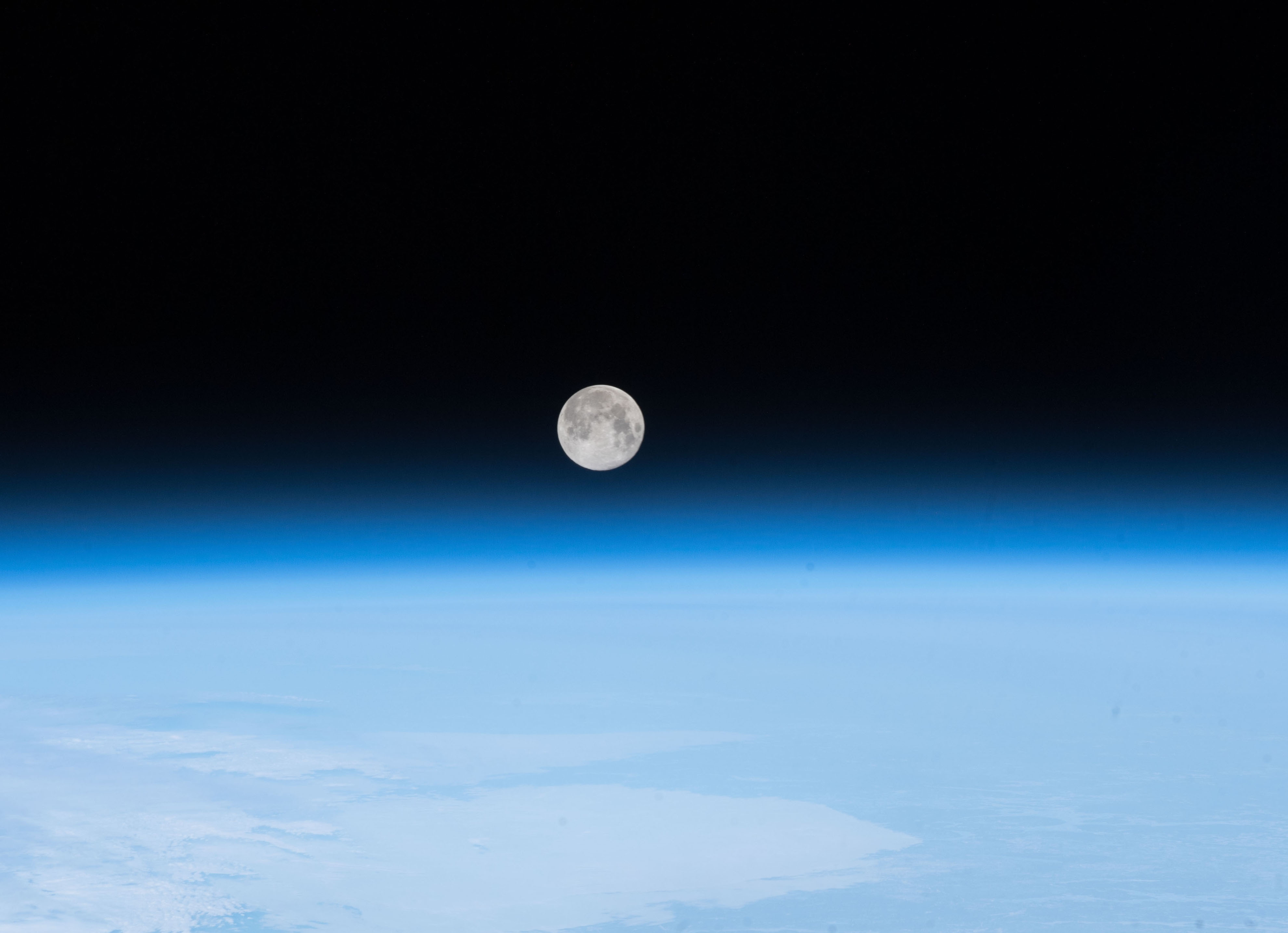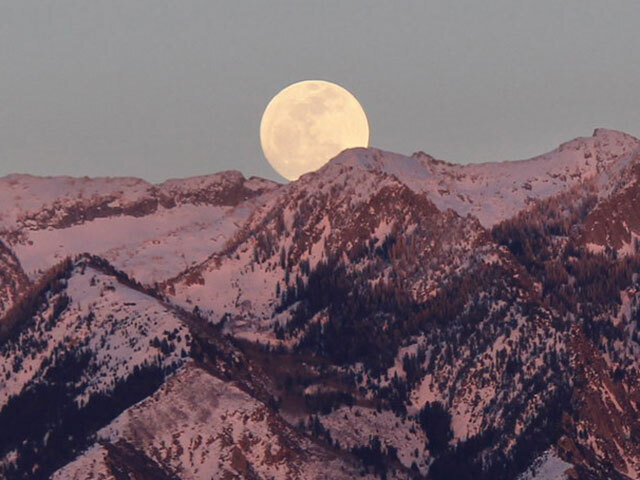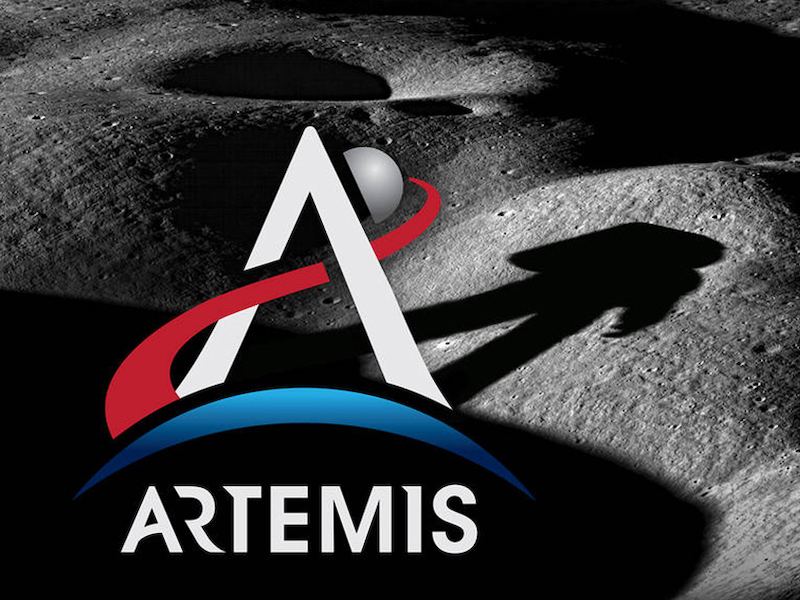News | October 17, 2018
The Next Full Moon is the Hunter's Moon

The crew of the International Space Station snapped this image of the full Moon on April 30, 2018. Image credit: NASA
The next full Moon will be on Wednesday mid-day, October 24, 2018, appearing "opposite" the Sun (in Earth-based longitude) at 12:45 PM EDT. The Moon will appear full for about three days centered around this time, from Tuesday morning through Thursday night.
The Hunter's Moon
This will be the Hunter's Moon, the full Moon after the Harvest Moon. According to the Farmer's Almanac, with the leaves falling and the deer fattened, it is time to hunt. Since the harvesters have reaped the fields, hunters can easily see the animals that have come out to glean (and the foxes that have come out to prey on them). The earliest use of the term "Hunter's Moon" cited in the Oxford English Dictionary is from 1710. Some sources suggest that other names for the Hunter's Moon are the Sanguine or Blood Moon, either associated with the blood from with hunting or the turning of the leaves in Fall.
The Maine Farmer's Almanac first published Indian names for the full Moons in the 1930's. According to this almanac, the Algonquin tribes of what is now the northern and eastern United States named the second full Moon of the Fall season the Beaver Moon. One interpretation is that mid-Fall was the time to set beaver traps before the swamps freeze to ensure a supply of warm winter furs. Another interpretation suggests that the name Beaver Moon came from how active the beavers are in this season as they prepare for winter. Other names for this Moon are the Frost or Frosty Moon and the Snow Moon, although these names are also used for the last Moon of Fall, in November this year but usually in December.
Many writers tie these Native American names to the European months, so that the full Moon in October is the Travel Moon or Dying Grass Moon, regardless of whether it is the first or second full Moon of Fall. To me, it makes more sense that the Native American tribes tied their Moon names to the seasons. Most of the time the names by European month correspond with the names by season, but right now they are out of sync, and will remain so until the Spring of 2019, when we will have a season with four full Moons.
This full Moon occurs around the seasonal end of the monsoon rains in the Indian Subcontinent. For Hindus, this full Moon is Sharad Purina, a harvest festival marking the end of the rains. For Buddhists, this full Moon is Pavarana, the end of Vassa (sometimes given the English names "Rains Retreat" or "Buddhist Lent"), the three-month period of fasting for Buddhist monks tied to the monsoons. In Laos this is all known as the Boun Suang Huea or Boat Racing Festival. In Sri Lanka, this is the Vap Poya, followed by the Kathina festival, during which people give gifts to the monks, particularly new robes, and this lunar month is sometimes called the Month of Robes. In Myanmar this is the Thadingyt Festival, also know as the Lightning Festival.
In lunisolar calendars the months change with the new Moon and full Moons fall in the middle of the lunar month. This full Moon falls near the middle of the ninth month in the Chinese calendar and Marcheshvan in the Hebrew calendar. In the Islamic calendar the months start with the first sighting of the waxing crescent Moon a few days after the New Moon. This full Moon is near the middle of Safar, the second month of the Islamic year.
As usual, the wearing of suitably celebratory celestial attire is encouraged in honor of the full Moon.
Mark Your Calendars
As for other celestial sights between now and the full Moon after next:
In mid-autumn the daily periods of sunlight continue to shorten. For the Washington, DC area, on the day of the full Moon on October 24, morning twilight will begin at 6:28 AM, sunrise will be at 7:27 AM, the Sun will reach a maximum altitude of 39.2 degrees at 12:52 PM, sunset will be at 6:17 PM, and evening twilight will end at 7:16 PM EDT. For Washington, DC, at least, the mornings from Thursday, October 25, to Saturday, November 3, 2018, will be the darkest mornings of the year, with the latest sunrise times. Sunrise on Saturday, November 3, 2018, will be 11 minutes later (in Daylight Savings Time) than the latest Winter sunrises in late December and early January (in Standard Time). On the last day of Daylight Savings Time, morning twilight will begin at 6:38 AM, sunrise will be at 7:38 AM. If you notice you have a lot of trouble waking up in the morning in late October and early November, this might be the reason (and even if it is not, it provides a plausible excuse for sleeping in...). On Sunday, November 4, 2018, at 2 AM EDT, we "fall back" to 1 AM EST, making the change to Standard Time. Twilight will begin at 5:39 AM, sunrise will be at 6:39 AM, the Sun will reach a maximum altitude of 35.6 degrees at 11:51 AM, sunset will be at 5:04 PM, and evening twilight will end at 6:04 PM EST. By the day of the full Moon on November 23, morning twilight will begin at 5:58 AM, sunrise will be at 7:00 AM, the Sun will reach a maximum altitude of 30.7 degrees at 11:54 AM, sunset will be at 4:49 PM, and evening twilight will end at 5:51 PM EST.
Your best bet for meteor watching will be in December with the annual Gemini meteor shower, expected to peak the morning of December 14, 2018 (I will write more about this in next month's Moon note). There will be some smaller meteor showers between now and the Geminids. In general, to see a meteor shower, you will need to be in a dark place far from city lights, with a clear sky (no clouds or haze), and a clear view of the sky. You will need to look after midnight and after the Moon has set, but before there is any trace of dawn in the sky. It can take your eyes 30 minutes or so to completely adapt to the dark, so no checking your smart phone between meteor watches.
The annual Orionid meteor shower, caused from debris from Halley's comet hitting the Earth's atmosphere at 66 km/sec (147,000 miles per hour), peaks on the morning of October 21, 2018. This shower will be still active through November 7, 2018. This year, moonlight interferes with the visibility of these meteors.
The annual Leonid meteor shower, caused from debris from the comet 55P/Tempel-Tuttle hitting the Earth's atmosphere at 71 km/sec (159,000 miles per hour), will be active from November 6 to 30, 2018, nominally expected to peak early in the morning of November 17, 2018. The International Meteor Organization's 2018 Meteor Shower Calendar discusses different models of the dust streams that indicate possible peaks from late on November 18 through early on November 20, with one additional dust trail on November 25, 2018, so there may be some surprises on when the peak actually occurs. For the dark countryside near the greater Washington, DC area, the Fluxtimator predicts between 4 and 5 visible meteors per hour in the hour or so before twilight begins. Getting to a dark mountaintop increases this prediction to about 7 meteors per hour.
A few other, more minor meteor showers are also active during this period, each only producing a few meteors per hour, but if you are in a place where the skies are dark and clear, and it is after midnight but before the sky starts to lighten with dawn, you might just catch a stray meteor or two.
On the evening of the full Moon on October 24, 2018, at about 30 minutes after sunset (around 6:45 PM EDT for the Washington, DC area), the brightest planet visible, Jupiter, will appear in the west-southwest at about 7 degrees above the horizon, with the third brightest planet visible, Mercury, to the lower right about 3 degrees above the horizon. Mercury will set at about 7:04 PM EDT. As evening twilight ends (at 7:16 PM EDT for the Washington, DC area), Jupiter will appear just 2 degrees above the horizon in the west-southwest. The second-most bright planet visible, Mars, will appear in the south-southeast about 31 degrees above the horizon, and the planet Saturn will appear between Mars and Jupiter in the southwest at about 22 degrees above the horizon. The bright star nearly directly overhead will be Deneb, one of the three stars in the "Summer Triangle" made up of Vega, the brightest star in the constellation Lyra the Harp; Deneb, the brightest star in the constellation Cygnus the Swan; and Altair, the brightest star in the constellation Aquila the Eagle. As the month progresses, the background of stars, along with the planets Jupiter and Saturn, will appear to shift towards the west, while Mars will appear to hover in the south-southeast and Mercury appears to shift away from the Sun in the west-southwest. For a brief period from November 6 to 12, 2018, Mercury will hover just on the horizon at the time evening twilight ends (for the Washington, DC area and similar latitudes). By the evening of the full Moon on November 23, 2018, Mercury and Saturn will be lost in the glow of the Sun. As evening twilight ends (at 5:51 PM EST for the Washington, DC area), the brightest planet visible will be Mars, appearing about 40 degrees above the horizon in the south. The planet Saturn will appear about 12 degrees above the horizon in the southwest. The bright stars of the Summer Triangle will appear a little west of directly overhead.
On the morning of full Moon on October 24, 2018, as morning twilight begins (at 6:28 AM EDT for the Washington, DC area), the bright stars of the local arm of our home galaxy will appear spread across the southwestern sky, with the brightest star, Sirius, shining about 33 degrees above the southern horizon. Over subsequent dawns the bright stars of the local arm will appear to shift towards the western horizon. After about November 1, 2018, the brightest of the planets, Venus, will begin to emerge from the glow of dawn in the east-southeast, about 30 minutes before sunrise, having passed between the Earth and the Sun on October 26, 2018. By November 4, 2018, Venus will be above the horizon at the time morning twilight begins. When Venus appears in the morning we call it the Morning Star. Other names include Phosphorus in Greek mythology and Tlāhuizcalpantecuhtli in Aztec mythology. With a backyard telescope Venus will appear as a crescent planet. By the morning of the full Moon on November 23, 2018, as morning twilight begins, Venus will appear about 20 degrees above the horizon in the east-southeast, and the bright stars of the local arm of our home galaxy will appear spread along the horizon in the west-southwest.
Even though they usually are not visible, I include in these Moon missives information about Near Earth Objects (mostly asteroids) that pass near the Earth, because I find it interesting that we have discovered so many. On Wednesday, October 17, 2018, sometime around noon EDT (2018-Oct-17 16:05 UTC with 3 hours 6 minutes uncertainty), Near Earth Object (2014 US7), between 14 and 31 meters (46 to 102 feet) in size, will pass the Earth at between 2.7 and 5.4 lunar distances (nominally 3.1), traveling at 8.69 kilometers per second (19,442 miles per hour).
Wednesday afternoon, October 17, 2018, at 3:16 PM EDT, the Moon will be at apogee, its farthest from the Earth for this orbit.
On Wednesday night, October 17, 2018, at 10:45 PM EDT (2018-Oct-18 02:45 UTC), Near Earth Object (2013 UG1), between 92 and 206 meters (302 to 676 feet) in size, will pass the Earth at 10.4 lunar distances, traveling at 13.42 kilometers per second (30,014 miles per hour).
On Thursday, October 18, 2018, sometime around 11 AM EDT (2018-Oct-18 14:42 UTC with 6 hours 4 minutes uncertainty), Near Earth Object (2016 GC221), between 29 and 65 meters (96 to 214 feet) in size, will pass the Earth at between 7.5 and 13.7 lunar distances (nominally 8.7), traveling at 14.40 kilometers per second (32,206 miles per hour).
On Wednesday evening, October 18, 2018, the bright planet Mars will appear to the left of the waxing gibbous Moon. For the Washington, DC area, they will appear about 6 degrees apart as evening twilight ends at 7:25 PM and will appear to shift closer together until the Moon sets in the west-southwest Thursday morning at 1:12 AM EDT.
As mentioned above, the annual Orionid meteor shower will peak the morning of Sunday, October 21, 2018 (although this shower sometimes has several peaks around this date). This year the nearly full Moon will reduce the number of meteors that you will be able to see, even under otherwise ideal conditions. Using the Fluxtimator at URL https://leonid.arc.nasa.gov/estimator.html it looks like (for the Washington, DC area, at least) there may be a short window the morning of October 21 between 6 and 6:20 AM EDT, after the Moon sets but before the sky begins to brighten with dawn, but given the predicted meteor rates, your chances of seeing some of these meteors will be good only if you have very clear skies and are far away from any cities or other sources of light.
As mentioned above, the next full Moon will be on Wednesday, October 24, 2018, at 12:45 PM EDT.
On Wednesday afternoon, October 24, 2018, at 4:30 PM EDT (2018-Oct-24 20:30 UTC), Near Earth Object (2018 TT5), between 22 and 49 meters (73 to 162 feet) in size, will pass the Earth at between 15.7 and 16.0 lunar distances (nominally 15.8), traveling at 10.24 kilometers per second (22,897 miles per hour).
Friday morning, October 26, 2018, is when the planet Venus passes between the Earth and the Sun as seen from Earth, called inferior conjunction.
On Friday evening into Saturday morning, October 26 to 27, 2018, the bright star Aldebaran will appear to the left of the waning, gibbous, nearly full Moon. For the Washington, DC area, the Moon will rise in the east-northeast at 7:58 PM, Aldebaran will rise to the lower left of the Moon at 8:25 PM. The pair will appear to shift closer together through the night and morning. The Moon will reach its highest in the sky Saturday morning at 3:08 AM, and Aldebaran will appear to the upper left of the Moon when morning twilight begins at 6:31 AM EDT.
On Monday morning, October 29, 2018, at 7:59 AM EDT (2018-Oct-29 11:59 UTC), Near Earth Object 475534 (2006 TS7), between 153 and 342 meters (502 to 1,122 feet) in size, will pass the Earth at 7.5 lunar distances, traveling at 18.11 kilometers per second (40,517 miles per hour).
On Monday evening, October 29, 2018, if you have a clear view of the horizon towards the west-southwest, you might be able to see the planets Jupiter and Mercury near each other. Try looking about 30 minutes after sunset (at about 6:42 PM EDT for the Washington, DC area), when Jupiter will appear about 6 degrees above the horizon and Mercury will appear about 3 degrees above the horizon. Mercury will set at 7:04 PM, evening twilight will end at 7:11 PM, and Jupiter will set at 7:20 PM EDT.
Wednesday, October 31, 2018, the waning Moon will appear half-full as it reaches its last quarter at 12:40 PM EDT. At 4:05 PM EDT, the Moon will be at perigee, its closest to the Earth for this orbit.
On Friday morning, November 2, 2018, the bright star Regulus will appear to the right of the waning crescent Moon. For the Washington, DC area, the Moon and Regulus will rise together in the east-northeast at 1:49 AM and the pair will appear high in the southeast when morning twilight begins at 6:37 AM EDT.
Daylight Savings Time will end on Sunday morning, November 4, 2018, when 1:59 AM EDT is followed by 1:00 AM EST.
On Sunday afternoon, November 4, 2018, at 4:43 PM EST (2018-Nov-04 21:43 UTC), Near Earth Object (2002 VE68), between 211 and 472 meters (693 to 1,549 feet) in size, will pass the Earth at 14.6 lunar distances, traveling at 8.63 kilometers per second (19,303 miles per hour).
On Monday afternoon, November 5, 2018, at about 1 PM EST (2018-Nov-05 18:03 UTC with 17 minutes uncertainty), Near Earth Object (2018 TF3), between 232 and 518 meters (760 to 1,698 feet) in size, will pass the Earth at between 7.7 and 7.8 lunar distances (nominally 7.8), traveling at 20.59 kilometers per second (46,064 miles per hour).
On Tuesday, November 6, 2018, the planet Mercury will be at its greatest angular separation from the Sun as seen from the Earth in the evening sky, called greatest eastern elongation, appearing half full when viewed by telescope.
Wednesday, November 7, 2018, at 11:02 AM EST, will be the new Moon, when the Moon passes between the Earth and the Sun and will not be visible from the Earth. The day after the New Moon marks the start of the new month for most lunisolar calendars. The five-day Hindu festival of lights, Diwali or Dipavali, is celebrated centered on the night of this new Moon, considered the darkest night of the Hindu lunisolar calendar. For more information see (for example) URL: https://en.wikipedia.org/wiki/Diwali
Sometime around the middle of the week of Wednesday, November 7, 2018 (2018-Nov-07 14:24 UTC with 2 days, 20 hours, 32 minutes uncertainty), Near Earth Object (2010 VQ), between 8 and 17 meters (25 to 56 feet) in size, will pass the Earth at between 14.7 and 16.4 lunar distances (nominally 15.6), traveling at 3.84 kilometers per second (8,588 miles per hour).
In the Islamic calendar the months start with the first sighting of the waxing crescent Moon a few days after the New Moon. Friday evening, November 9, 2018, will mark the beginning of Rabīʿ al-Awwal, the third month of the calendar, in which the birthday of the Prophet Muhammad is celebrated. To see the thin crescent Moon with the planet Mercury below, try looking at the horizon between the west-southwest and southwest at about 30 minutes after sunset (around 5:29 PM EST). Jupiter will appear near the horizon to the right, Saturn higher in the sky to the left, and the bright star Antares might be visible below Mercury.
Wednesday morning, November 14, 2018, at 10:57 AM EST, the Moon will be at apogee, its farthest from the Earth for this orbit.
In the mornings in mid-November 2018, the bright star Spica will appear to the upper right of the bright planet Venus. They will appear at their closest, about a degree apart, on the morning of Wednesday, November 14, 2018. For the Washington, DC area, Spica will rise in the east-southeast at 4:34 AM, Venus will rise at 4:40 AM, and morning twilight will begin at 5:49 AM EST, when the pair will appear about 12 degrees above the horizon.
On Thursday morning, November 15, 2018, the Moon will appear half-full as it reaches its first quarter at 9:54 AM EST.
On Thursday evening, November 15, 2018, the bright planet Mars will appear near the first quarter Moon. Mars will appear to the upper left of the Moon as evening twilight ends (at 5:55 PM for the Washington, DC area), the Moon will reach its highest in the sky for the evening at 6:30 PM, and the pair will appear to shift closer together until the Moon sets in the west-southwest at 11:53 PM EST.
As mentioned above, the annual Leonid Meteor Shower is predicted to peak the morning of Saturday, November 17, 2018, with a predicted meteor rate (for dark, rural areas near Washington, DC) of about 4 or 5 meteors per hour.
The full Moon after next will be early on Friday morning, November 23, 2018, at 12:39 AM EST.






